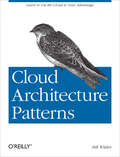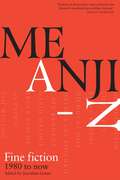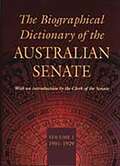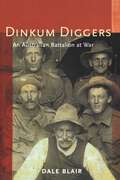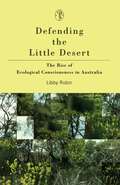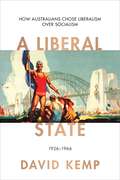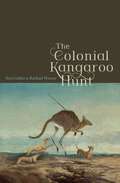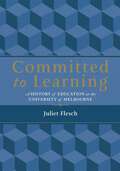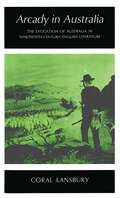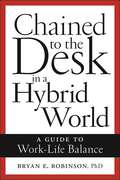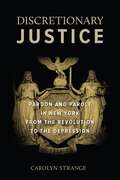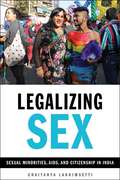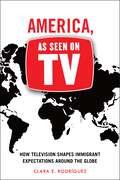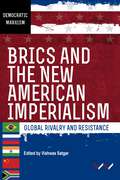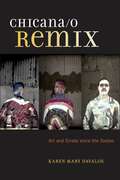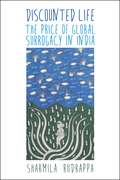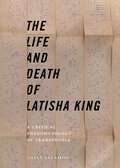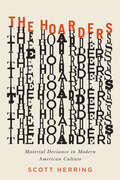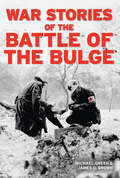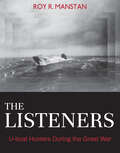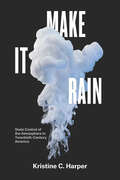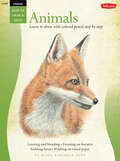- Table View
- List View
Cloud Architecture Patterns: Using Microsoft Azure
by Bill WilderIf your team is investigating ways to design applications for the cloud, this concise book introduces 11 architecture patterns that can help you take advantage of cloud-platform services. You’ll learn how each of these platform-agnostic patterns work, when they might be useful in the cloud, and what impact they’ll have on your application architecture. You’ll also see an example of each pattern applied to an application built with Windows Azure.The patterns are organized into four major topics, such as scalability and handling failure, and primer chapters provide background on each topic. With the information in this book, you’ll be able to make informed decisions for designing effective cloud-native applications that maximize the value of cloud services, while also paying attention to user experience and operational efficiency.Learn about architectural patterns for:Scalability. Discover the advantages of horizontal scaling. Patterns covered include Horizontally Scaling Compute, Queue-Centric Workflow, and Auto-Scaling.Big data. Learn how to handle large amounts of data across a distributed system. Eventual consistency is explained, along with the MapReduce and Database Sharding patterns.Handling failure. Understand how multitenant cloud services and commodity hardware influence your applications. Patterns covered include Busy Signal and Node Failure.Distributed users. Learn how to overcome delays due to network latency when building applications for a geographically distributed user base. Patterns covered include Colocation, Valet Key, CDN, and Multi-Site Deployment.
Meanjin A-Z: Fine Fiction 1980 to Now
by Meanjin QuarterlyThink of an Australian writer and chances are that at some time or another they've had short fiction published in Meanjin. For the first time a treasure trove of this writing leaps from the pages of Meanjin into a book of fine fiction. You'll read Tim Winton, David Malouf and recent work by Jennifer Mills. In between you'll find John Kinsella, Nicholas Jose, Bruce Pascoe, Melissa Lucashenko, A.S. Patric and many more.
Biographical Dictionary of the Australian Senate Volume 1
by Ann MillarThe Biographical Dictionary of the Australian Senate covers the period 1901–1929, the period in which the Parliament operated from Melbourne. This first volume provides short articles on Australia's Senators during the first thirty years of the Federal Parliament. These entries place particular emphasis on the events of a Senator's parliamentary experience, contributions to debates, committee work, parliamentary positions as well as ministerial appointments. It provides also a window on the colonial and post-colonial societies in which these ninety-nine Senators and their three Clerks lived and worked. It explains how miners, merchants, constitutionalists, soldiers, printers, trade unionists, adventurers and pastoralists became Senators, and how, in an essentially egalitarian society, they melded together as Australia's first federal parliamentarians. It tells of their work as legislators during a period when Australia was making a unique contribution to democracy itself, and reveals the excitement felt by conservatives and non-conservatives alike as they shaped the beginnings of an Australian nation. The contribution of these Senators to Australian public life was immense. The Federationists, Richard Baker, John Downer, Thomas Playford, Richard O'Connor, James Walker, Henry Dobson, William Trenwith, Simon Fraser, Josiah Symon and William Zeal retain some elemens of notoriety. Others, such as the South Australian farmer, William Russell, or Charles Montague Graham, a tailor on the Western Australian goldfields, were soon forgotten, even in their own time. The Biographical Dictionary of the Australian Senate reveals to a new generation the influence and the significance of men who came from all sides of politics and the social spectrum, and were able parliamentarians and true representatives of the democratic process. This readable and authoritative work of reference will provide readers with a biographical account of all Australian senators, and a history of the Senate since 1901. It makes a scholarly contribution to historical and parliamentary knowledge and fills many gaps in our knowledge of less well-known senators whose careers have not been fully documented before.
Dinkum Diggers: An Australian Battalion at War
by Dale James BlairTall, sun-bronzed, hardy. Resourceful, independent, egalitarian. Scornful of authority, loyal to their mates. These mythical characteristics of the Anzac 'diggers' are central to our idea of what it is to be Australian. But did the soldiers themselves fit the stereotype? How closely does the myth match the reality? This penetrating study strips away celebratory generalisations and measures the Anzac legend against the actual experiences of one battalion that fought at Gallipoli and on the Western Front in World War I. The diaries and letters written by soldiers of the 1st Battalion reveal attitudes, insights, comments and criticisms that qualify and even contradict the Anzac legend. In Dinkum Diggers, Dale James Blair compares these first-hand accounts by front-line infantrymen with unit diaries, operational records, service and repatriation records, as well as with interviews with family members and statistical analysis, to present a well-rounded picture of the complexities of the 1st Battalion's experience. By narrowing the focus of Australian war experience to a single battalion, he demonstrates nuances and subtleties, showing how the men viewed and reacted to their own officers and how both officers and men behaved in combat. He follows these war-damaged soldiers into civilian life, where they mostly kept quiet as conservative forces worked to enshrine and sanitise Australia's sacrifice. This book makes a notable contribution to revisionist studies about World War I. It is a patient, thorough and scholarly demolition job on the Anzac legend, a reality check on back-slapping triumphalism and the glorification of war.
Defending The Little Desert: The Rise of Ecological Consciousness in Australia
by Libby RobinIn 1968 Sir William McDonald, Victoria's Minister of Lands, announced a rural settlement scheme for the Little Desert in Victoria's far north-west. The conservation campaign that ensued was one of unprecedented vehemence and sophistication. It cost McDonald his parliamentary seat and consigned the Little Desert Settlement Scheme to oblivion. The Little Desert dispute was a watershed in Australian environmental politics. Suburban activists, scientists, amateur naturalists, economists and bureaucrats banded together to oppose McDonald's ill-conceived scheme. It marked the beginning of a new consciousness of nature and the concept of `biological diversity' was voiced in the halls of parliament for the first time. In Defending the Little Desert, Libby Robin offers a sensitive account of the unlikely coalition of forces that assembled to save the Little Desert. This beautifully written account of the campaign, perhaps the earliest expression of ecological consciousness in Australia, will be read by all Australians interested in conservation and the environment, in participatory political processes and in 'public science'.
Liberal State: How Australians Chose Liberalism over Socialism 1926–1966
by David KempA Liberal State: How Australians Chose Liberalism over Socialism 1926-1966 explores the revival of Australian political liberalism after the Great Depression of the 1930s and its sweeping domestic political triumph after World War II over utopian socialism. The fourth title in a landmark five-volume Australian Liberalism series, A Liberal State examines how Australians reasserted their claim to control their own lives, following decades of expanded government control over economic and social life, and intrusive wartime and post-war restrictions. From the 1920s Robert Menzies became the major voice for liberal thought in the nation's political life and David Kemp looks at his role in reconstructing liberal and conservative politics. The book highlights the importance of the factional struggles within the Labor Party arising from its adoption of a Socialist Objective, and the domestic and international advance of utopian socialist ideology during World War II and the Cold War. A Liberal State tells of Jack Lang's advocacy of the socialisation of industry in New South Wales in the 1930s, and of Menzies as war-time prime minister and his key relationship with John Curtin. It assesses Menzies's historic Forgotten People statement of liberal ideas, the formation of the Liberal Party of Australia, and how, after his election victory in 1949, Menzies rebuilt a liberal basis for national policy during sixteen and a half years as prime minister.
Colonial Kangaroo Hunt
by Ken Gelder Rachael WeaverFrom the arrival of Captain James Cook in 1770 to classic children's tale Dot and the Kangaroo, Ken Gelder and Rachael Weaver examine hunting narratives in novels, visual art and memoirs to discover how the kangaroo became a favourite quarry, a relished food source, an object of scientific fascination, and a source of violent conflict between settlers and Aboriginal people. The kangaroo hunt worked as a rite of passage and an expression of settler domination over native species and land. But it also enabled settlers to begin to comprehend the complexity of bush ecology, raising early concerns about species extinction and the need for conservation and the preservation of habitat.
Committed to Learning: A History of Education at the University of Melbourne
by Juliet FleschConsistently ranking in the top five educational faculties in the world, the Melbourne Graduate School of Education has achieved a status few would have predicted. This history of the first hundred and ten years of the discipline of Education at the University of Melbourne reflects the extraordinary change in the esteem in which it has been held, in the university, Australia and the world. The very idea of Education as a suitable course of study at a university was initially opposed, and until recently the standing of this faculty compared to other professional faculties such as Law or Medicine has been less than equal. But since the University was revitalised and reorganised under the Melbourne Model in 2008, its reputation has risen steadily. Committed to Learning brings to life those whose vision and hard work since its early beginning have brought such success to this faculty.
Golden Age: A History of the Colony of Victoria 1851–1861
by Geoffrey SerleAn outstanding account of a decade whose highlights included separation from New South Wales, the gold rushes, the Eureka Stockade, the establishment of parliamentary government, and the attempts to 'unlock the land'.
Arcady in Australia: The evocation of Australia in nineteenth-century English Literature
by Coral LansburyThis provocative book examines the vision of Australia in nineteenth-century English literature. The industrial revolution destroyed the myth of an idyllic rural way of life in England, and writers like Charles Dickens, Bulwer Lytton and Charles Reade created it anew in the improbable environment of Australia. The popular image of Australia in English literature was Arcadian; in turn it dominated the thought and traditions of writing in Australia. The man who supplied the material for English writers was Samuel Sidney; he was for a time regarded as an expert on Australia, although he had never set foot in the antipodes and all his material was second-hand. His influence on the literature of the period, and consequently on Australia, has received scant attention. Sidney's influence is fully examined; the book also offers entirely new material on Wakefield, Dickens, Lytton and Reade. It provides a new and challenging interpretation of literature and social history in both England and Australia.
Chained to the Desk in a Hybrid World: A Guide to Work-Life Balance
by Bryan E. RobinsonA step-by-step guide to reestablishing work-life balanceAmericans love a hard worker. The employee who toils eighteen-hour days and eats meals on the run between appointments is usually viewed with a combination of respect and awe. But for many, this lifestyle leads to family problems, a decline in work productivity, and, ultimately, physical and mental burnout. Intended for anyone touched by what Robinson calls “the best-dressed problem of the twenty-first century,” Chained to the Desk in a Hybrid World provides an inside look at the impact of work stress on those who live and work with workaholics—partners, spouses, children, and colleagues—as well as the appropriate techniques for clinicians who treat them.This groundbreaking book builds on the research included in three previous editions of Chained to the Desk from the best-selling author and widely respected family therapist Bryan E. Robinson. In the wake of the COVID-19 pandemic and the rise of working from home, Robinson finds that the agonies of work stress have only become more challenging. Recent years have seen an unprecedented shift to remote work, which has made it significantly harder to maintain the already delicate work-life balance, weakened as it is by smartphones and other technology. The result is that many workaholics are more stressed and burnt out than ever before in their work, despite being constantly in the presence of family. Chained to the Desk in a Hybrid World both counsels and consoles. It provides a step-by-step guide to help readers spot, understand, and ultimately recover from workaholism.
Discretionary Justice: Pardon and Parole in New York from the Revolution to the Depression
by Carolyn StrangeThe pardon is an act of mercy, tied to the divine right of kings. Why did New York retain this mode of discretionary justice after the Revolution? And how did governors’ use of this prerogative change with the advent of the penitentiary and the introduction of parole? This book answers these questions by mining previously unexplored evidence held in official pardon registers, clemency files, prisoner aid association reports and parole records. This is the first book to analyze the histories of mercy and parole through the same lens, as related but distinct forms of discretionary decision-making. It draws on governors’ public papers and private correspondence to probe their approach to clemency, and it uses qualitative and quantitative methods to profile petitions for mercy, highlighting controversial cases that stirred public debate. Political pressure to render the use of discretion more certain and less personal grew stronger over the nineteenth century, peaking during constitutional conventionsand reaching its height in the Progressive Era. Yet, New York’s legislators left the power to pardon in the governor’s hands, where it remains today. Unlike previous works that portray parole as the successor to the pardon, this book shows that reliance upon and faith in discretion has proven remarkably resilient, even in the state that led the world toward penal modernity.
Legalizing Sex: Sexual Minorities, AIDS, and Citizenship in India
by Chaitanya LakkimsettiHow the rise of HIV in India resulted in government protections for gay groups, transgender people, and sex workers This original ethnographic research explores the relationship between the HIV/AIDS epidemic and the rights-based struggles of sexual minorities in contemporary India. Sex workers, gay men, and transgender people became visible in the Indian public sphere in the mid-1980s when the rise of HIV/AIDS became a frightening issue. The Indian state started to fold these groups into national HIV/AIDS policies as “high-risk” groups in an attempt to create an effective response to the epidemic. Lakkimsetti argues that over time the crisis of HIV/AIDS effectively transformed the relationship between sexual minorities and the state from one that was focused on juridical exclusion to one of inclusion. The new relationship then enabled affected groups to demand rights and citizenship from the Indian state that had been previously unimaginable. By illuminating such tactics as mobilizing against a colonial era anti-sodomy law, petitioning the courts for the recognition of gender identity, and stalling attempts to criminalize sexual labor, this book uniquely brings together the struggles of sex workers, transgender people, and gay groups previously studied separately. A closely observed look at the machinations behind recent victories for sexual minorities, this book is essential reading across several fields.
America, As Seen on TV: How Television Shapes Immigrant Expectations around the Globe
by Clara E. RodríguezFinalist, 2020 Latino Book Awards, Best Academic Themed BookThe surprising effects of American TV on global viewers As a dominant cultural export, American television is often the first exposure to American ideals and the English language for many people throughout the world. Yet, American television is flawed, and, it represents race, class, and gender in ways that many find unfair and unrealistic. What happens, then, when people who grew up on American television decide to come to the United States? What do they expect to find, and what do they actually find? In America, As Seen on TV, Clara E. Rodríguez surveys international college students and foreign nationals working or living in the US to examine the impact of American television on their views of the US and on their expectations of life in the United States. She finds that many were surprised to learn that America is racially and economically diverse, and that it is not the easy-breezy, happy endings culture portrayed in the media, but a work culture. The author also surveys US-millennials about their consumption of US TV and finds that both groups share the sense that American TV does not accurately reflect racial/ethnic relations in the US as they have experienced them. However, the groups differ on how much they think US TV has influenced their views on sex, smoking and drinking. America, As Seen on TV explores the surprising effects of TV on global viewers and the realities they and US millennials actually experience in the US.
BRICS and the New American Imperialism: Global rivalry and resistance
by Vishwas Satgar Ferrial Adam Samir Amin Patrick Bond William K Carroll Christopher Chase-Dunn Alexander Gallas Ana Garcia Karina Kato Nivedita Majumdar Keamogetswe SeipatoChallenges the mainstream understanding of BRICS and US dominance to situate the new global rivalries engulfing capitalismBRICS is a grouping of the five major emerging economies of Brazil, Russia, India, China and South Africa. Volume five in the Democratic Marxism series, BRICS and the New American Imperialism challenges the mainstream understanding of BRICS and US dominance to situate the new global rivalries engulfing capitalism. It offers novel analyses of BRICS in the context of increasing US induced imperial chaos, deepening environmental crisis tendencies (such as climate change and water scarcity), contradictory dynamics inside BRICS countries and growing subaltern resistance. The authors revisit contemporary thinking on imperialism and anti-imperialism, drawing on the work of Rosa Luxemburg, one of the leading theorists after Marx, who attempted to understand the expansionary nature of capitalism from the heartlands to the peripheries. The richness of Luxemburg’s pioneering work inspires most of the volume’s contributors in their analyses of the dangerous contradictions of the contemporary world as well as forms of democratic agency advancing resistance.While various forms of resistance are highlighted, among them water protests, mass worker strikes, anti-corporate campaigning and forms of cultural critique, this volume grapples with the challenge of renewing anti-imperialism beyond the NGO-driven World Social Forum and considers the prospects of a new horizontal political vessel to build global convergence. It also explores the prospects of a Fifth International of Peoples and Workers.
Chicana/o Remix: Art and Errata Since the Sixties
by Karen Mary DavalosRewrites our understanding of the last 50 years of Chicana/o cultural production. Chicana/o Remix casts new light not only on artists—such as Sandra de la Loza, Judy Baca, and David Botello, among others—but on the exhibitions that feature their work, and the collectors, curators, critics, and advocates who engage it. Combining feminist theory, critical ethnic studies, art historical analysis, and extensive archival and field research, Karen Mary Davalos argues that narrow notions of identity, politics, and aesthetics limit our ability to understand the full capacities of Chicana/o art. She employs fresh vernacular concepts such as the “errata exhibit,” or the staging of exhibits that critically question mainstream art museums, and the “remix,” or the act of bringing new narratives and forgotten histories from the background and into the foreground. These concepts, which emerge out of art practice itself, drive her analysis and reinforce the rejection of familiar narratives that evaluate Chicana/o art in simplistic, traditional terms, such as political versus commercial, or realist versus conceptual. Throughout Chicana/o Remix, Davalos explores undocumented or previously ignored information about artists, their cultural production, and the exhibitions and collections that feature their work. Each chapter exposes and challenges conventions in art history and Chicana/o studies, documenting how Chicana artists were the first to critically challenge exhibitions of Chicana/o art, tracing the origins of the first Chicano arts organizations, and highlighting the influence of Europe and Asia on Chicana/o artists who traveled abroad. As a leading scholar in the study of Chicana/o artists, art spaces, and exhibition practices, Davalos presents her most ambitious project to date in this re-examination of fifty years of Chicana/o art production.
Discounted Life: The Price of Global Surrogacy in India
by Sharmila RudrappaWinner, American Sociological Association Asia and Asian America Section Best Book on Asia/Transnational AsiaFinalist, 2015 C. Wright Mills Award from the Society for the Study of Social Problems India is the top provider of surrogacy services in the world, with a multi-million dollar surrogacy industry that continues to grow exponentially, as increasing numbers of couples from developed nations look for wombs in which to grow their babies. Some scholars have exulted transnational surrogacy for the possibilities it opens for infertile couples, while others have offered bioethical cautionary tales, rebuked exploitative intended parents, or lamented the exploitation of surrogate mothers—but very little is known about the experience of and transaction between surrogate mothers and intended parents outside the lens of the many agencies that control surrogacy in India. Drawing from rich interviews with surrogate mothers and egg donors in Bangalore, as well as twenty straight and gay couples in the U.S. and Australia, Discounted Life focuses on the processes of social and market exchange in transnational surrogacy. Sharmila Rudrappa interrogates the creation and maintenance of reproductive labor markets, the function of agencies and surrogacy brokers, and how women become surrogate mothers. Is surrogacy solely a labor contract for which the surrogate mother receives wages, or do its meanings and import exceed the confines of the market? Rudrappa argues that this reproductive industry is organized to control and disempower women workers and yet her interviews reveal that, by and large, the surrogate mothers in Bangalore found the experience life affirming. Rudrappa explores this tension, and the lived realities of many surrogate mothers whose deepening bodily commodification is paradoxically experienced as a revitalizing life development. A detailed and moving study, Discounted Life delineates how local labor markets intertwine with global reproduction industries, how Bangalore’s surrogate mothers make sense of their participation in reproductive assembly lines, and the remarkable ways in which they negotiate positions of power for themselves in progressively untenable socio-economic conditions.
Goodbye Religion: The Causes and Consequences of Secularization (Secular Studies)
by Ryan T. Cragun Jesse M. SmithExamines why so many are leaving religion, and what that means for American society One of the largest changes in American culture over the last fifty years has been the increase in people exiting religion. Goodbye Religion explores why there has been such an upswing among those who identify as nonreligious, and what the societal implications are of this move towards less religiosity. Utilizing nationally representative data and more than a hundred in-depth interviews with people who leave their religion behind, Ryan T. Cragun and Jesse M. Smith examine the variety of social, psychological, and environmental conditions behind the exiting process, as well as what people do with the time they used to devote to religious observance. They show that for most people who leave, abandoning religion is not a crisis, and does not generally disrupt their health, charitable giving, or volunteering. Drawing on the data, Cragun and Smith argue that the fears among some that massive religious exit will result in a decline in family values or less civic engagement are unfounded, and that those who become nonreligious remain engaged in society and continue to strive to make the world a better place. At a time where more and more individuals are questioning the implications of our increasingly secular society, Goodbye Religion offers an engaging and fascinating analysis into what religious exiting—and secularization broadly—means for American society.
The Life and Death of Latisha King: A Critical Phenomenology of Transphobia (Sexual Cultures #10)
by Gayle SalamonWhat can the killing of a transgender teen can teach us about the violence of misreading gender identity as sexual identity?The Life and Death of Latisha King examines a single incident, the shooting of 15-year-old Latisha King by 14-year-old Brian McInerney in their junior high school classroom in Oxnard, California in 2008. The press coverage of the shooting, as well as the criminal trial that followed, referred to Latisha, assigned male at birth, as Larry. Unpacking the consequences of representing the victim as Larry, a gay boy, instead of Latisha, a trans girl, Gayle Salamon draws on the resources of feminist phenomenology to analyze what happened in the school and at the trial that followed. In building on the phenomenological concepts of anonymity and comportment, Salamon considers how gender functions in the social world and the dangers of being denied anonymity as both a particularizing and dehumanizing act. Salamon offers close readings of the court transcript and the bodily gestures of the participants in the courtroom to illuminate the ways gender and race were both evoked in and expunged from the narrative of the killing. Across court documents and media coverage, Salamon sheds light on the relation between the speakable and unspeakable in the workings of the transphobic imaginary. Interdisciplinary in both scope and method, the book considers the violences visited upon gender-nonconforming bodies that are surveilled and othered, and the contemporary resonances of the Latisha King killing.
The Sword of Ambition: Bureaucratic Rivalry in Medieval Egypt (Library of Arabic Literature #38)
by ʿUthmān ibn al-NābulusīThe Sword of Ambition belongs to a genre of religious polemic written for the rulers of Egypt and Syria between the twelfth and the fourteenth centuries. Unlike most medieval Muslim polemic, the concerns of this genre were more social and political than theological. Leaving no rhetorical stone unturned, the book’s author, an unemployed Egyptian scholar and former bureaucrat named 'Uthman ibn Ibrahim al-Nabulusi (d. 660/1262), poured his deep knowledge of history, law, and literature into the work. Now edited in full and translated for the first time, The Sword of Ambition opens a new window onto the fascinating culture of elite rivalry in the late-medieval Islamic Middle East. It contains a wealth of little-known historical anecdotes, unusual religious opinions, obscure and witty poetry, and humorous cultural satire. Above all, it reveals that much of the inter-communal animosity of the era was conditioned by fierce competition for scarce resources that were increasingly mediated by an ideologically committed Sunni Muslim state. This insight reminds us that seemingly timeless and inevitable “religious” conflict must be considered in its broader historical perspective.The Sword of Ambition is both the earliest and most eclectic of several independent works composed in medieval Egypt against the employment of Coptic and Jewish officials, and is vivid testimony to the gradual integration of Islamic scholarship and state administration that was well underway in its day.A bilingual Arabic-English edition.
The Hoarders: Material Deviance in Modern American Culture
by Scott HerringThe verb “declutter” has not yet made it into the Oxford English Dictionary, but its ever-increasing usage suggests that it’s only a matter of time. Articles containing tips and tricks on how to get organized cover magazine pages and pop up in TV programs and commercials, while clutter professionals and specialists referred to as “clutterologists” are just a phone call away. Everywhere the sentiment is the same: clutter is bad. In The Hoarders, Scott Herring provides an in-depth examination of how modern hoarders came into being, from their onset in the late 1930s to the present day. He finds that both the idea of organization and the role of the clutterologist are deeply ingrained in our culture, and that there is a fine line between clutter and deviance in America. Herring introduces us to Jill, whose countertops are piled high with decaying food and whose cabinets are overrun with purchases, while the fly strips hanging from her ceiling are arguably more fly than strip. When Jill spots a decomposing pumpkin about to be jettisoned, she stops, seeing in the rotting, squalid vegetable a special treasure. “I’ve never seen one quite like this before,” she says, and looks to see if any seeds remain. It is from moments like these that Herring builds his questions: What counts as an acceptable material life—and who decides? Is hoarding some sort of inherent deviation of the mind, or a recent historical phenomenon grounded in changing material cultures? Herring opts for the latter, explaining that hoarders attract attention not because they are mentally ill but because they challenge normal modes of material relations. Piled high with detailed and, at times, disturbing descriptions of uncleanliness, The Hoarders delivers a sweeping and fascinating history of hoarding that will cause us all to reconsider how we view these accumulators of clutter.
War Stories of the Battle of the Bulge
by Michael Green James D. Brown“Told by those who lived during . . . Hitler’s last gasp attack in the West . . . a riveting book for anybody with an interest in the Second World War.” —CurledUpThe powerful German counteroffensive operation codenamed “Wacht am Rhein” (Watch on the Rhine) launched against the American First Army in the early morning hours of December 16, 1944, would result in the greatest single extended land battle of World War II. To most Americans, the fierce series of battles fought in the Ardennes Forest of Belgium and Luxembourg that winter is better known as the Battle of the Bulge. Here are the first-person stories of the American soldiers who repelled the powerful German onslaught that had threatened to turn the tide of battle in Western Europe during World War II.
The Listeners: U-boat Hunters During the Great War (Garnet Bks.)
by Roy R. ManstanAn untold story of scientists and engineers who changed the course of World War I Roy R. Manstan's new book documents the rise of German submarines in World War I and the Allies' successful response of tracking them with innovative listening devices—precursors to modern sonar. The Listeners: U-boat Hunters During the Great War details the struggle to find a solution to the unanticipated efficiency of the German U-boat as an undersea predator. Success or failure was in the hands and minds of the scientists and naval personnel at the Naval Experimental Station in New London, Connecticut. Through the use of archival materials, personal papers, and memoirs The Listeners takes readers into the world of the civilian scientists and engineers and naval personnel who were directly involved with the development and use of submarine detection technology during the war.
Make It Rain: State Control of the Atmosphere in Twentieth-Century America
by Kristine C. HarperWeather control. Juxtaposing those two words is enough to raise eyebrows in a world where even the best weather models still fail to nail every forecast, and when the effects of climate change on sea level height, seasonal averages of weather phenomena, and biological behavior are being watched with interest by all, regardless of political or scientific persuasion. But between the late nineteenth century—when the United States first funded an attempt to “shock” rain out of clouds—and the late 1940s, rainmaking (as it had been known) became weather control. And then things got out of control. In Make It Rain, Kristine C. Harper tells the long and somewhat ludicrous history of state-funded attempts to manage, manipulate, and deploy the weather in America. Harper shows that governments from the federal to the local became helplessly captivated by the idea that weather control could promote agriculture, health, industrial output, and economic growth at home, or even be used as a military weapon and diplomatic tool abroad. Clear fog for landing aircraft? There’s a project for that. Gentle rain for strawberries? Let’s do it! Enhanced snowpacks for hydroelectric utilities? Check. The heyday of these weather control programs came during the Cold War, as the atmosphere came to be seen as something to be defended, weaponized, and manipulated. Yet Harper demonstrates that today there are clear implications for our attempts to solve the problems of climate change.
Drawing: Learn How to Draw with Colored Pencil, Step-by-Step (How to Draw & Paint)
by Debra Kauffman YaunAn easy to read, how-to guide with complete instructions for creating lifelike portraits of wild and domestic animals using colored pencils.In this comprehensive, thirty-two–page book, accomplished artist Debra Kauffman Yaun shares her artistic insights and techniques for creating strikingly realistic animal drawings in colored pencil. The book opens with essential information on choosing tools and materials, understanding color theory, and creating basic pencil strokes. It then covers special colored pencil techniques, such as hatching, burnishing, layering, and blending. Finally, the author demonstrates how to accurately depict an assortment of adorable animals—including favorite family pets, wildlife, and birds—in a series of clear, step-by-step lessons. In-depth, easy-to-follow instructions allow aspiring artists to develop their drawing skills, guiding them from simple sketches to the final flourishes.
